

Story
생활 서비스 혁신
로봇 배송의 시대가 온다
Innovation of Daily Living Services
Era of Robot Deliveries
기계공학부 서태원 교수
Prof. TaeWon Seo, Department of Mechanical Engineering
- 글 박영임
- 사진 이현구
- Writing Park Yeong-im
- Photograph Lee Hyeon-gu
Scroll Down
How would you feel if robots delivered products to you? Recently, Professor TaeWon Seo developed a "last mile" delivery robot platform “WAVES” that can travel on stairs as well as on flat surfaces. It is highly marketable when applied to unmanned delivery service, as goods are delivered to your door with the robot system. We talked with Professor Seo about the robots that will be incorporated into daily living services.
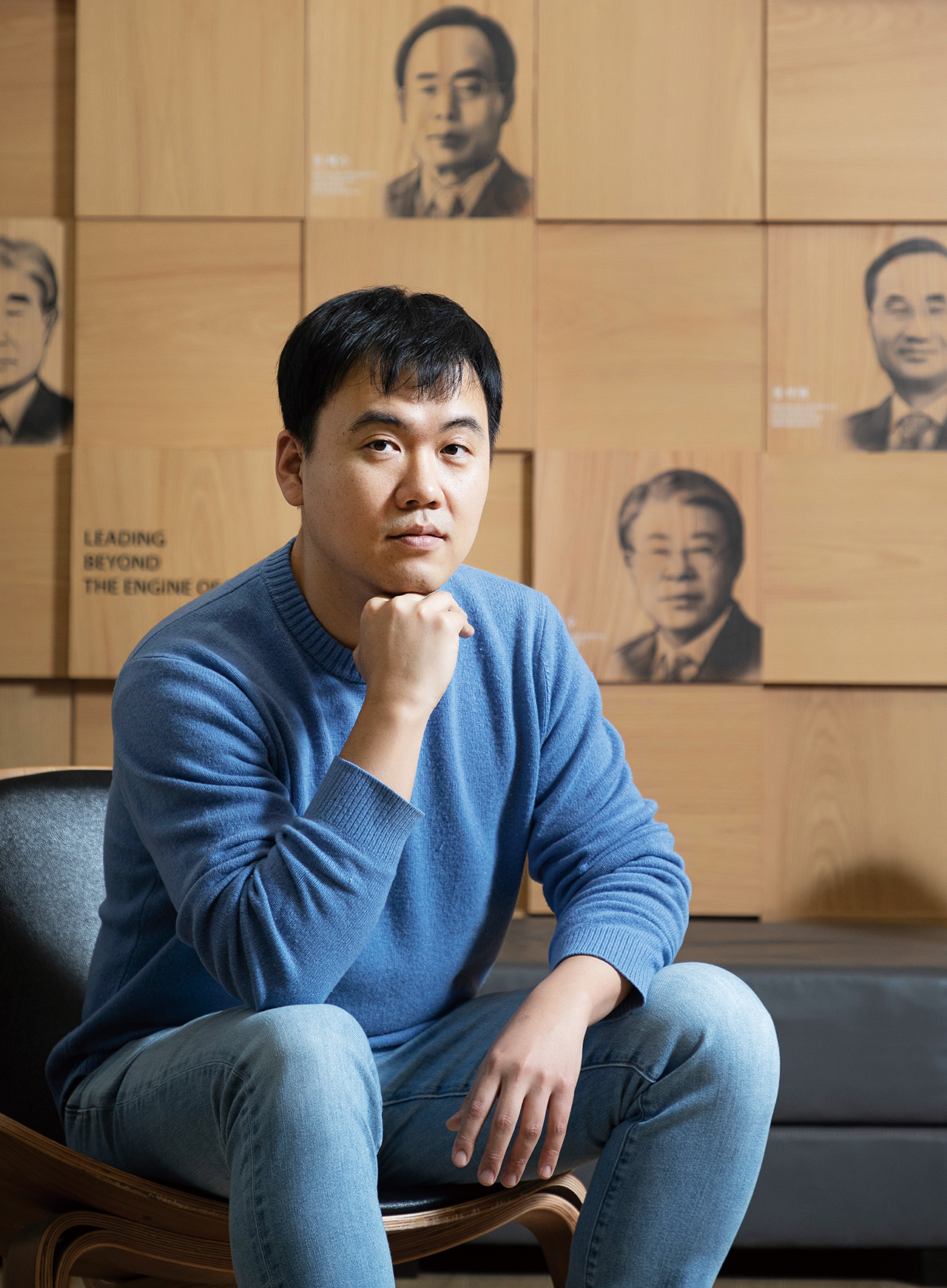
배송 로봇 현실화 임박
“최근 식당에서 요리된 음식을 테이블까지 배송해주는 서빙 로봇을 많이 보았을 것입니다. 이와 유사하게 택배 차량이 집 근처에 진입하면 그 택배 상자를 집 앞까지 배달한다든지, 주문한 음식을 집 앞까지 배송해주는 라스트 마일 배송 로봇들이 상용화되거나 준비 중입니다. 배송 로봇에 적용되는 자율주행 기술, 위치인식 기술, 메커니즘 기술은 이미 성숙 단계에 있으나 관련 법규 마련, 이용자들의 인식 전환, 로봇 친화적인 인프라 구축 등이 필요한 상황입니다.”
지난 1월 CES 2023에서 새로운 개념의 라스트 마일 배송 로봇 플랫폼인 ‘웨이브에스’를 공개한 서태원 교수는 배송 로봇이 보급되기 위해서는 넘어야 할 선결과제가 있다고 강조했다. 마침 지난 2월 자율주행 로봇의 보도 통행을 가능하게 하는 도로교통법 개정안이 국회행정안전위원회 법안심사2소위를 통과한 데 이어, 3월에는 정부에서 ‘첨단로봇 규제혁신 방안’을 발표해 배송 로봇의 상용화가 급물살을 타고 있다. 정부는 연내 지능형로봇법을 개정해 실외 이동로봇의 정의와 안정성에 대한 기준을 신설하고, 실외 배송 로봇의 보행자 통로 주행을 허용하는 도로교통법 개정을 추진하기로 했다. 머지않아 우리는 거리에서 배송 로봇들이 바쁘게 배달 다니는 모습을 볼 수 있게 될 것이다.
라스트 마일 배송 로봇은 주문자의 집 앞까지 배송해줘야 하므로 계단을 오르거나 턱을 넘어가는 등 국내 주택 환경에 맞는 기술 개발이 요구된다. 서태원 교수가 선보인 웨이브에스는 4절 링크 구조를 채택해 동작을 생성하고 바닥에 붙어있는 소프트 재질의 발판을 이용해 다양한 크기와 구조의 계단에 적응할 수 있도록 설계됐다. 특히 배송 차량에서 집 앞까지 택배 상자를 싣고 이동하는 배송 로봇에 적용하는 것이 목적이다.
“모바일 로봇 관련 연구를 하고 있어 서비스 로봇 기반 메커니즘에 관심이 많습니다. 바퀴를 변형하거나 스마트 휠을 이용해 장애물을 넘는 로봇, 링키지와 휠을 이용해 계단을 극복하는 로봇 등의 설계 및 제어 연구를 하고 있습니다. 다양한 로봇에 대한 설계 및 안정적인 구동을 위한 제어 문제를 해결하는 것이 과제입니다.”
Realization of delivery robots
“You’ve probably recently seen server robots in restaurants that deliver food to tables. Similarly, last-mile delivery robots that takes the delivery boxes or ordered food to your doors are being commercialized, or in the process of being commercialized. Self-driving, location recognition, and mechanism technologies are already completed. What we now need are the relevant laws, changes in people’s perspectives, and a robot-friendly infrastructure.”
Professor TaeWon Seo, who unveiled a new concept last-mile delivery robot platform, “WAVES,” at CES 2023 in January, said that there are prior tasks that must be completed for delivery robots to be distributed. In February, an amendment to the Road Traffic Act that allows self-driving robots to pass on the sidewalks was passed by the second subcommittee of the National Assembly’s Public Administration and Security Committee, thus speeding up the commercialization of delivery robots. The government plans to amend the Intelligent Robots Act to establish new standards on definition and safety of outdoor mobile robots, and to push ahead with amendments that allow outdoor delivery robots to travel on pedestrian walkways. Soon, we will be able to see robots busily making deliveries on the streets.
Since last-mile delivery robots need to take the goods to people's doors, there is a need to develop technologies suitable for Korea’s housing environment, such as climbing up the stairs and going over raised spots. Professor Seo’s WAVES is designed to adapt to stairs of various sizes and structures, by making motions with a four-bar link mechanism and using the foothold made of soft material at the bottom. The goal is to apply it to delivery robots that carry the delivery boxes from the car.
“Since I am doing research on mobile robots, I am very interested in service robot-based mechanisms. We are conducting researches on designing and controlling of robots that take care of obstacles by transforming wheels or using smart wheels, and climb stairs by using linkages and wheels. The challenge is to design various robots and solve the control problems for stable operation.”
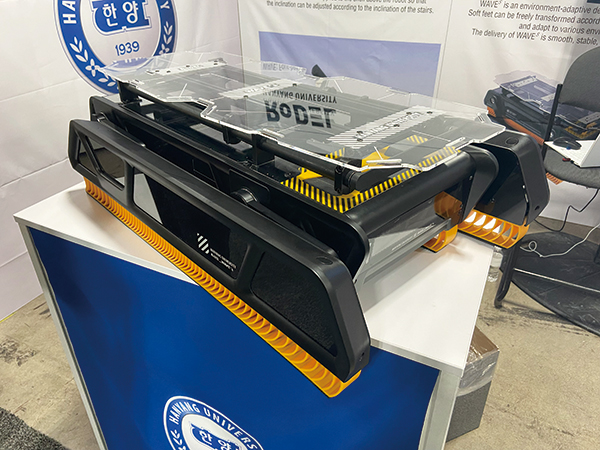
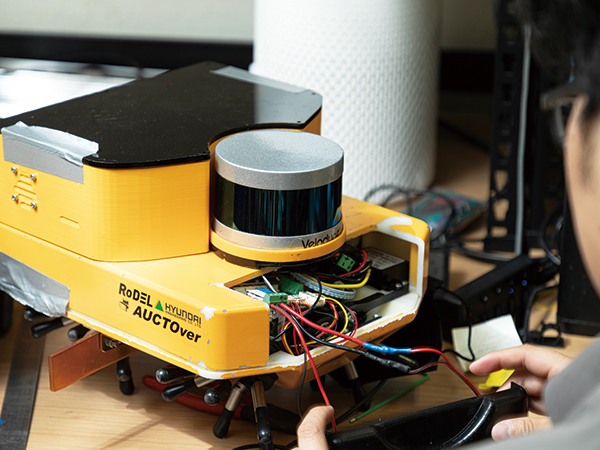
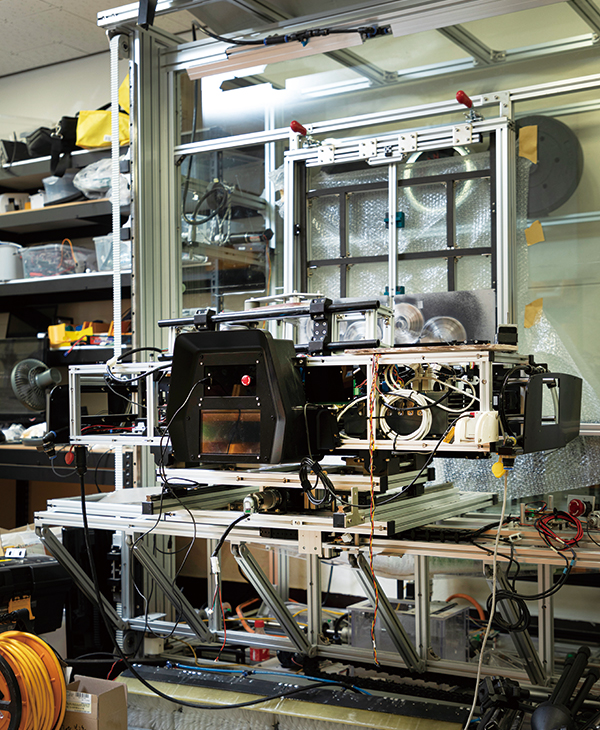
국내 산업용 로봇 밀도 세계 1위
로봇설계공학연구실을 운영하는 서태원 교수는 배송 로봇 플랫폼 외에도 양팔로 수중 작업을 할 수 있는 수중 로봇, 벽에 붙어 이동할 수 있는 벽면 등반 로봇, 수면과 지면을 동시에 보행할 수 있는 수륙 양용 로봇 등 다양한 로봇 기술을 연구해왔다. 서태원 교수가 이러한 로봇 설계 및 제어 기술을 연구하는 이유는 명백하다. 바로 전문 서비스 로봇에 적용해 실생활에 활용하기 위한 것이다. 예를 들어 벽면 등반 로봇 기술로 고층 빌딩 외벽을 빠르게 청소하는 외벽청소 로봇 ‘에델스트로’를 개발했는데, 이는 2020년 한국기계기술단체총연합회의 올해의 10대 기계기술로 선정됐고, 같은 해 레드닷 어워드에서 혁신제품 부문상을 받은 바 있다.
“고층 빌딩의 외벽을 청소하는 작업은 매우 고되고 위험한 일입니다. 이러한 극한 조건의 작업을 로봇이 대신해주면 사람은 좀 더 편하고 창의적인 작업을 할 수 있죠. 어려운 환경에서 작업해야 하는 로봇은 요구조건을 맞추기가 더욱 어렵습니다. 예를 들어 외벽에서 이동하는 전문 서비스 로봇의 경우, 외벽의 특성을 모델링하고 분석해 제어하는 것이 어려운 점이죠. 하지만 실제 상용화될 수 있는 로봇을 개발하려면 그러한 요구조건을 정확히 파악해 특성을 분석하고 그에 적합한 설계와 제어를 해야 합니다.”
오래전부터 전 세계적으로 로봇에 관한 연구가 활발하게 진행돼 왔지만, 일반인들이 실생활 속에서 로봇을 접하게 된 것은 얼마 되지 않았다. 하지만 서태원 교수는 모터와 센서에 기반해 스스로 작동한다는 광의의 개념으로 보자면 냉장고도 로봇으로 볼 수 있다고 말한다. 그러니 우리가 인식하는 것보다 더 오랜 시간을 로봇과 함께해왔다고 할 수 있을 것이다. 그렇다면 우리나라의 로봇 기술은 어떤 수준일까.
“모르는 사람이 많지만 우리나라는 로봇이 제일 보편화된 나라입니다. 조사에 따르면 노동자 1만 명당 로봇 비율이 세계 1위(국제로봇연맹 2021년)를 차지할 정도로 로봇을 많이 활용하고 있습니다. 기술 수준도 이에 발맞춰 발전했습니다. 특히 로봇 설계, 제어, 센싱, 플래닝 등에서는 시스템 응용 측면에서 세계적인 수준이라고 생각합니다. 하지만 액추에이터, 센서 등 요소기술에서는 아직 부족한 점이 있습니다.”
Highest industrial robot density in the world
Professor TaeWon Seo, who runs the Robot Design Engineering Lab, has developed various robots in addition to the delivery robot platform, such as underwater robots that can work with both arms underwater, a wall-climbing robot that can move on walls, and an amphibious robot that can walk on surfaces of both ground and water. The reason why Professor Seo is studying such robot design and control technology is clear. He wants to apply it to service robots for use in everyday life. For example, he developed Edelstro, a robot that cleans the exterior walls of skyscrapers with wall-climbing technology. It was selected as one of the ten mechanical technologies of the year in 2020 by the Korean Federation of Mechanical Engineering Societies, and won the Best Innovative Product at the Red Dot Design Awards in the same year.
“Cleaning the exterior walls of skyscrapers is very difficult and dangerous. If robots can take over these extreme jobs, people can do more creative work conveniently. For robots that work in difficult conditions, it is harder to meet the requirements. For example, in the case of service robots that move on exterior walls, it is difficult to control by modeling and analyzing the characteristics of the wall. However, in order to develop robots that can actually be commercialized, you need to accurately understand these requirements, analyze the characteristics, and design and control accordingly.”
Though Researches on robots have been actively conducted worldwide for a long time, it has not been long that the general public has come into contact with robots in their daily lives. However, Professor Seo says that refrigerators can also be considered robots in the broader sense of the definition, as they operate on their own based on motors and sensors. In other words, we have been with robots longer than we think. What then is the level of robot technology in Korea?
“Although many people are unaware, Korea is the country where robots are the most common. According to a survey, we use robots to such an extent where the number of robots per 10,000 working persons is the highest in the world (International Federation of Robotics 2021). The level of technology has also developed along with it. In particular, in terms of system application in robot design, control, sensing, and planning, I believe Korea has world-class technology. However, we still lack elementary technology such as actuators and sensors.”
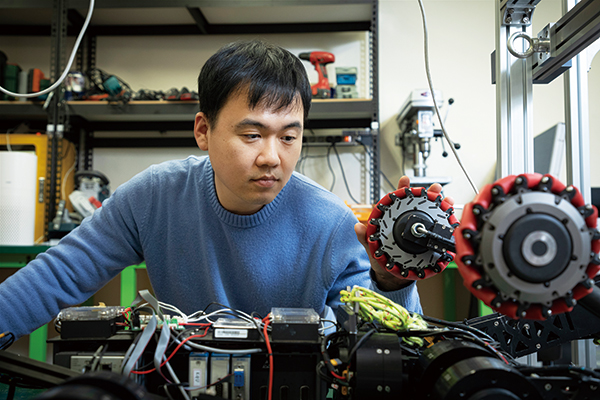
로봇의 보편화로 인간이 어렵고 힘든 육체노동에서 해방될 수 있다면 사회는 조금 더 좋은 방향으로 진행될 것이다
If humans can be freed from difficult and strenuous physical labor through the distribution of robots, society will move further in a better way.
로봇 통해 육체노동에서 해방
서두에서 서빙 로봇을 쉽게 접할 수 있게 된 현실을 언급한 바 있다. 그렇다면 사용한 식기를 수거하는 로봇도 필요하지 않을까. 그래서 서태원 교수는 KIST, 성균관대, 티로보틱스와 함께 식기 수거 로봇에 대한 연구를 수행하고 있다. 공동연구팀에서 서태원 교수는 다양한 크기, 형상의 식기류를 잡을 수 있는 그리퍼를 설계하는 역할을 맡았다. 제각각인 식기류와 음식물, 그리고 환경 등을 모두 고려해 연구를 진행해야 한다는 어려움이 있지만 처음 시도하는 연구라는 점에서 의미가 크다.
“인터넷의 발명으로 사회가 많이 변화된 것은 사실이지만, 개인적으로는 세탁기의 발명이 더 중요했다고 생각합니다. 세탁기가 보급됨으로써 세탁 시간이 줄고 그 시간을 다른 창의적인 일에 사용하면서 사회는 더욱 발전할 수 있었습니다. 로봇의 보편화로 어렵고 힘든 육체노동에서 해방될 수 있다면 사회는 좀 더 좋은 방향으로 진행되지 않을까 기대합니다.”
이것이 바로 서태원 교수가 생각하는 로봇이 가져다줄 미래이며, 로봇을 연구하는 궁극적인 목표다. 로봇의 어원이 체코어로 중노동, 강제노동 등을 뜻하는 ‘로보타(robota)’인 만큼, 앞으로 다양한 로봇들이 등장해 인간의 노동을 대신해줄 것이다. 서태원 교수는 인공지능 기술과 모빌리티 기술 접목이 더욱더 고도화한다면 완전 자율주행 자동차나 설거지하는 로봇 등 소설, 영화 속에서만 보았던 것들을 일상에서 목격할 날이 머지않았다고 말했다. 마지막으로 서태원 교수는 로봇에 대한 새로운 아이디어들이 실용화되는 사례가 조금 더 많아지면 좋겠다며, 로봇을 연구하고자 하는 이들에게 다음과 같은 당부를 남겼다.
“로봇은 종합 학문입니다. 로봇은 사람과 같은 공간에서 사용되어야 하며, 로봇이 사람에게 끼치는 영향도 매우 크기 때문에 법, 도덕, 사회 시스템, 인프라 구축 등 고려해야 할 것들이 많습니다. 로봇 연구를 프로그래밍, 설계, 제어에 국한하지 말고, 다양한 것을 경험하고 상상하며 연구하기를 바랍니다.”
Free from manual labor through robots
Serving robots in restaurants was mentioned earlier in this article. Wouldn’t we also need robots that take away used dishes? Professor Seo is conducting research on dish-collecting robots with KIST, Sungkyunkwan University, and T-ROBOTICS. In the joint research team, Professor Seo is in charge of designing a gripper that can hold dishes of various shapes and sizes. Although it is difficult to take into account dishes of various types, foods, and the environment, the research is meaningful in that it is the first attempt.
“It is true that society has changed a lot with the invention of the Internet. However, I believe that the invention of washing machines was more important. With the use of washing machines, the time used for laundry could be used for more creative things, thus allowing society to develop further. If we can be free from difficult and strenuous physical labor through the distribution of robots, I believe society will go further in a better way.”
This is the future that Professor TaeWon Seo thinks robots will bring to us, the ultimate goal in robot research. The etymology of robot is “robota,” which means hard or forced labor in Czech. In the future, various robots will replace such labor for humankind.
Professor Seo points out that when the integration of artificial intelligence technology and mobility technology advances further, it won’t be long before we can witness things that we have till now seen only in novels and movies, such as fully self-driving vehicles and dish-washing robots, in our daily lives. Lastly, Professor Seo left following requests to those who plan to study robots, saying that he wants to hear of more cases where new ideas on robots can be put to practical use.
“Robotics is a multidisciplinary field. Robots are used in the same space as humans, and thus have a great impact on humans. So, there are many things to consider, such as laws, ethics, social systems, and infrastructure. I hope you will not just see your robot studies to programming, design, and control, but experience, imagine, and study, explore the area in various aspects.”
